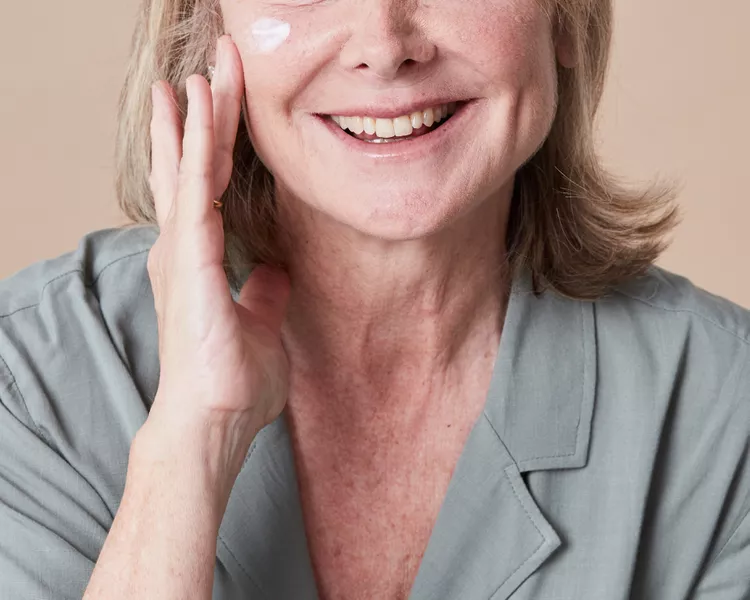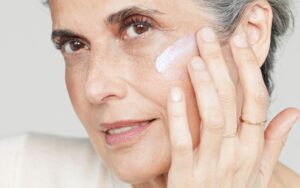
Με τα χρόνια εμφανίζονται στο πρόσωπο καφέ ή μαύρα σημάδια, κυρίως στις περιοχές που βλέπει ο ήλιος, στο πρόσωπο και στα χέρια. Αυτά τα σημάδια μπορεί να έχουν διαφορετικά ονόματα αλλά όλα είναι πιο σκούρα από το γύρω τους δέρμα γι αυτό και λέγονται «κηλίδες» ή «δυσχρωμίες». Τα συχνότερα είναι το μέλασμα (ή πανάδα) και οι ηλιακές φακές.
Πως προκύπτουν αυτά; Στην επιδερμίδα μας έχουμε όλοι μελανοκύτταρα, κύτταρα δηλαδή που παράγουν μία ουσία, την μελανίνη που ευθύνεται για το χρώμα μας. Οι άνθρωποι με πιο σκούρο δέρμα έχουν πιο δραστήρια μελανοκύτταρα που παράγουν περισσότερη μελανίνη, ενώ οι ανοιχτόχρωμοι λιγότερη. Η μελανίνη στη συνέχεια μοιράζεται ομοιόμορφα στα κερατινοκύτταρα, στα κύρια δηλαδή κύτταρα της επιδερμίδας μας. Όταν το δέρμα μας εκτίθεται σημαντικά στον ήλιο, κάποια στιγμή τα μελανοκύτταρα παράγουν σε συγκεκριμένα σημεία παραπάνω μελανίνη και αυτό προκαλεί τις ηλιακές φακές και το μέλασμα. Σε ότι αφορά το μέλασμα, συχνά πυροδοτείται και από ορμονικές αλλαγές όπως η εγκυμοσύνη, τα αντισυλληπτικά ή οι θεραπείες υποκατάστασης που ίσως παίρνουμε στην εμμηνόπαυση. Γίνεται χειρότερο με την υπεριώδη ακτινοβολία, αλλά ξέρουμε ότι το επηρεάζει και το ορατό φως και η υπέρυθρη ακτινοβολία από συσκευές.
Τι μπορούμε να κάνουμε λοιπόν για τις δυσχρωμιες;
Πρώτη σκέψη είναι πάντα η πρόληψη. Ποτέ δεν είναι αργά να προλάβουμε το να γίνουν χειρότερες οι δυσχρωμίες μας ή να εμφανιστούν νέες. Γνωρίζουμε ότι υπαίτιος για την εμφάνισή τους είναι ο ήλιος και φυσικά όταν τον αποφεύγουμε αυτές ελαττώνονται. Ακόμα και όταν ο καιρός δεν είναι καλός, οι υπεριώδεις ακτίνες (κυρίως οι UVA) διαπερνούν τα σύννεφα και φτάνουν στο δέρμα μας για να διεγείρουν την παραγωγή μελανίνης. Είναι επίσης γνωστό ότι και το ορατό φως και ίσως και το υπέρυθρο μπορούν να προκαλέσουν παραγωγή μελανίνης, ειδικότερα σε σκούρα δέρματα. Γι αυτό είναι πολύ σημαντικό να εφαρμόζουμε αντηλιακό κάθε μέρα 365 μέρες τον χρόνο και για τα σκουρότερα δέρματα να επιλέγουμε αντηλιακά προϊόντα με ειδικά φυσικά φίλτρα ή χρωστικές που να προστατεύουν και από το ορατό φως. Ποτέ δεν είναι αργά να αποκτήσουμε μία σωστή συμπεριφορά στον ήλιο, να αναζητούμε την σκιά, να φοράμε καπέλο και να εφαρμόζουμε σωστό αντηλιακό κάθε μέρα.
Ρόλο στην πρόληψη των δυσχρωμιών έχουν και τα αντιοξειδωτικά, κι αυτό γιατί έχει αποδειχθεί ότι οι οξειδωτικές βλάβες από καυσαέρια σε πόλεις αυξάνουν την πιθανότητα εμφάνισης δυσχρωμιών. Με τα αντιοξειδωτικά λοιπόν εξουδετερώνουμε σε έναν βαθμό αυτόν τον κίνδυνο.
Έπειτα, επόμενο βήμα μετά την πρόληψη είναι η προσπάθεια να εξαφανίσουμε τα σκούρα σημάδια, τις κηλίδες. Αυτό ίσως γίνεται με κρέμες που περιέχουν λευκαντικές ουσίες που ελαττώνουν την παραγωγή μελανίνης από τα μελανοκύττταρα. Τέτοιες ουσίες είναι η υδροκινόνη (που έχει περιορισμούς στην χρήση της στην Ευρώπη και συνταγογραφείται από δερματολόγους), το αζελαικό οξύ, το κοχικό οξύ, η συστεαμίνη, το τρανεξαμικό οξύ και άλλες ουσίες. Άλλη προσέγγιση είναι οι ουσίες που εμποδίζουν την μεταφορά της μελανίνης στα κερατινοκύτταρα, για παράδειγμα η νιασιναμίδη. Μπορούμε επίσης να εφαρμόσουμε ουσίες που κάνουν κερατόλυση, δηλαδή απομακρύνουν από την επιδερμίδα κερατινοκύτταρα που έχουν αυξημένη χρωστική και έτσι το χρώμα του δέρματος είναι πιο ομοιόμορφο. Για παράδειγμα οξέα φρούτων, τοπικά ρετινοειδή ή σαλικυλικό οξύ. Ιδανικά, όταν μιλάμε για λεύκανση του δέρματος με κρέμες, αντιμετωπίζουμε το πρόβλημα από πολλές πλευρές, συνδυάζουμε διαφορετικές ουσίες με διαφορετικές δράσεις για καλύτερο αποτέλεσμα.
Ο δερματολόγος μας προτείνει ποιος συνδυασμός είναι καλύτερος για κάθε άτομο. Φυσικά, δουλειά του δερματολόγου στη διάρκεια της εξέτασης είναι και να επιβεβαιώσει ότι η δυσχρωμία είναι αθώα για την υγεία μας και ότι δεν πρόκειται για κάποια καρκινική ή προκαρκινική βλάβη. Επίσης, ο δερματολόγος ίσως ενισχύσει την προσπάθεια λεύκανσης με κρέμες με ειδικές θεραπείες που γίνονται στο ιατρείο.






No comment yet, add your voice below!